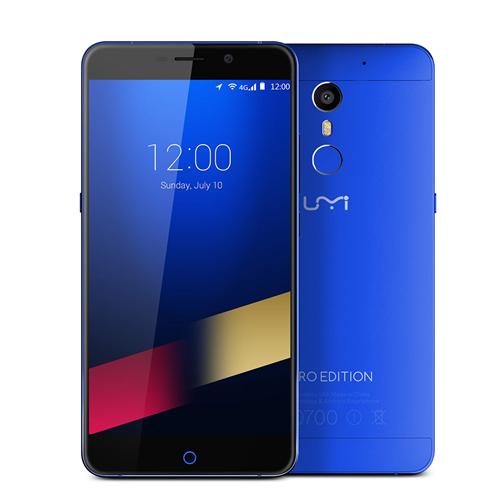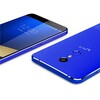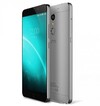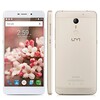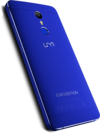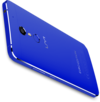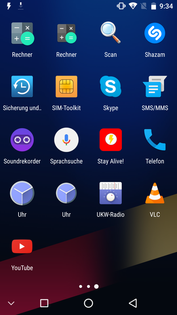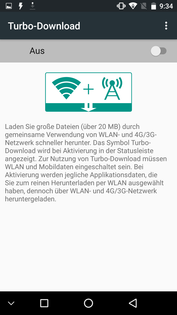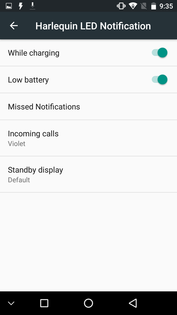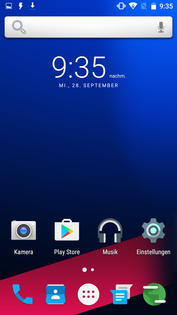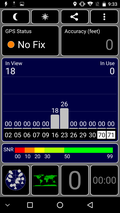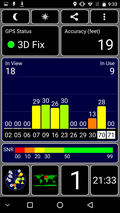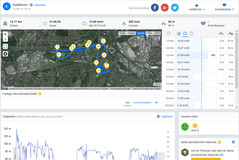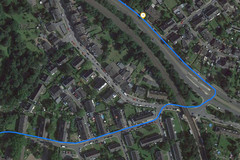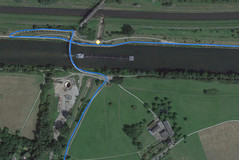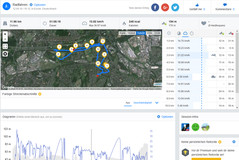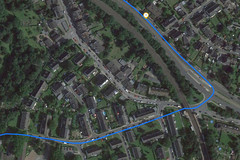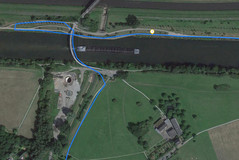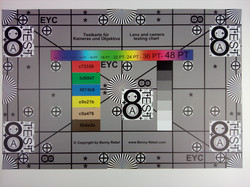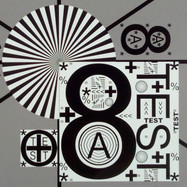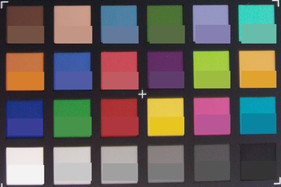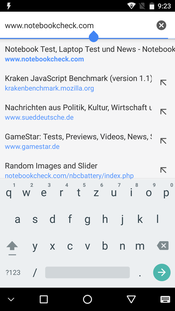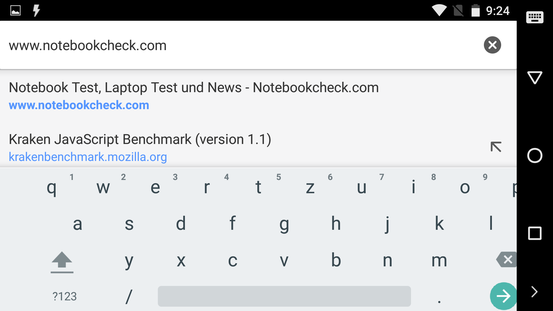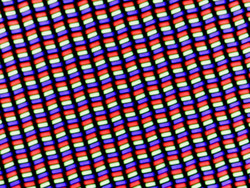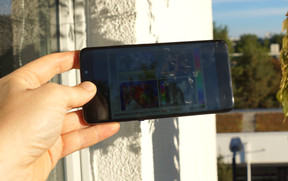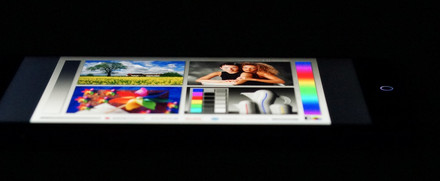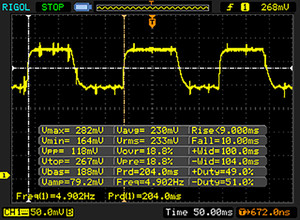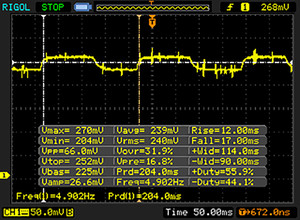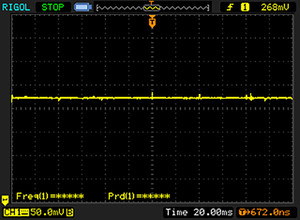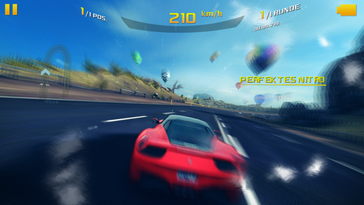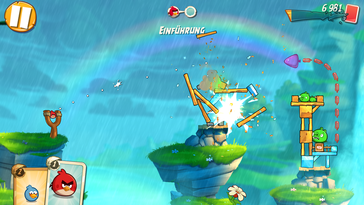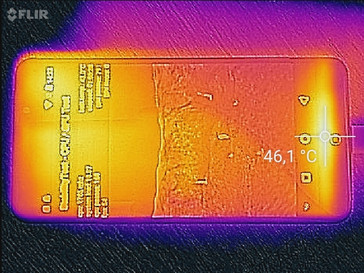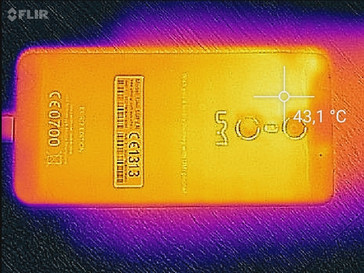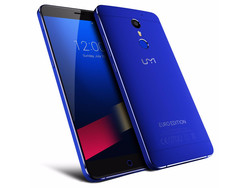UMi Super Euro Edition Smartphone Review
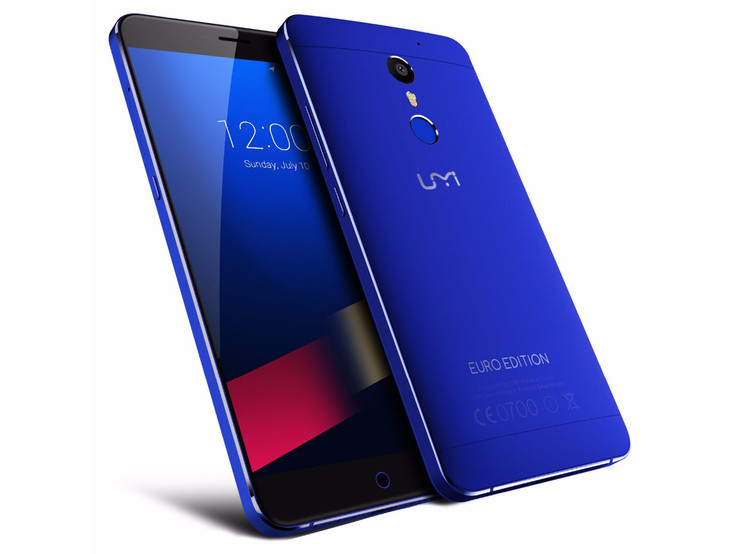
The UMi Super Euro Edition commemorates the European Soccer Championship which took place in July. Since UMi doesn't have an official license, the company mentions this fact just casually. UMi only produced 999 of the limited-edition smartphone and offered them to pre-registered users via a lottery.
Users who don't like the hype can also purchase the "normal" UMi Super - although the pretty blue is not an option then, only gold or silver. The smartphone offers quite a bit for the money (200 Euro/~$225): 32 GB of storage, 4 GB of RAM, fingerprint sensor, Full-HD display, and high-res cameras.
But how "super" is the UMi Super really? To find out, we'll compare it to the Acer Liquid Zest Plus, the Lenovo ZUK Z2, the Honor 5X and the Blackview R7.
Case
The UMi Super is certainly no lightweight and tips our scales at 202 grams. The chassis is made out of aluminum with 2.5D glass up front and a blue back panel. The smartphone does look pretty good, but we don't like the slightly darker plastic inserts in the upper and lower portions of the back. This material and the different hue look anything but upscale.
The build quality suffers in a few areas: some edges protrude, which is quite noticeable when running the finger across. The chassis itself is pretty sturdy, but pressure on the screen is visible on the display; same is true when pressing on the back. Torsional rigidity is great and twisting attempts aren't accompanied by creaking sounds. The overall build quality is decent.
Connectivity
The USB C port at the bottom only runs at USB 2.0 speeds, but USB OTG is supported, so the user can connect external USB drives. 4 GB of RAM seem pretty generous, but this amount is not necessarily a rarity: other smartphones in this category - like the Lenovo ZUK Z2 or the Blackview R7 - also feature the same amount. 32 GB of storage is also not class-leading, as most competitors offer at least the same amount, if not more. Some upper-middle class smartphones aren't any more generous in this area, so the UMi Super is rather well-equipped for the price.
FM Radio, Dual-SIM, fingerprint sensor and a microSD cardslot are on board as well. NFC is absent, however. Apps can't be transferred to the SD card, but the card can be formatted as internal storage if so desired.
Software
Android 6.0 is preinstalled and Android 7 supposedly will be released around Christmas time. The interface hasn't been tweaked much, so Android users should feel right at home. The settings menu contains some extra options, but otherwise this is a vanilla install.
The smarthphone lacks any bloatware, which we certainly appreciate - but useful tools are missing as well. Most of what we would wish for can either be downloaded for free or purchased inexpensively from the Google Play store. Some of the notifications are only in English - a German translation is not offered.
Communication and GPS
The UMi supports all German LTE bands - not a given when dealing with Chinese Smartphones. The OnePlus One, for example, had issues with Vodafone in the past. The UMi Super only offers four frequencies in each of the telephony systems (GMS, UMTS, and LTE), so it's not particularly well-suited for use on other continents. At least the smartphone supports LTE Cat. 6, which allows theoretical speeds of up to 200 MBit/sec. The reception quality in the city is decent with about 3/4 signal strength in buildings, but full bars outdoors when connected to Vodafone.
Either one or two Micro-SIM cards are required. One slot supports LTE, the other only GSM - but the user gets to decide which slot supports what speed.
The smartphone can connect to 802.11 a/b/g/n, but the much faster 802.11 ac technology is not supported. The UMi Super does support the less crowded 5 GHz band, however. During our standardized WLAN test - conducted one meter from our reference router Linksys EA8500 - the smartphone proved its worth, as it had the highest transfer rates amongst its peers. We experienced somewhat sluggish real-world performance when loading web pages close to the router, but the performance didn't drop even through three walls and 10 meters / 33 feet away from router - and that despite the fact that the signal strength was down to 50 %.
| Networking | |
| iperf Server (receive) TCP 1 m | |
| Lenovo ZUK Z2 | |
| UMI Super Euro Edition | |
| Blackview R7 | |
| Acer Liquid Zest Plus | |
| iperf Client (transmit) TCP 1 m | |
| Lenovo ZUK Z2 | |
| UMI Super Euro Edition | |
| Blackview R7 | |
| Acer Liquid Zest Plus | |
The GPS was unable to establish a connection inside. Outdoors, we had to wait a while but we were able to pinpoint our location with an accuracy of 7 meters / 23 feet - an acceptable result.
To conduct a more practical test, we take the UMi Super and the professional GPS Garmin Edge 500 on a bike ride. According to the Garmin Edge 500, we covered 12.17 - the UMi Super claims 11.96 km, for a difference of 200 m, which is totally acceptable. The UMi Super cuts a corner here or there and records a straight line instead of a curve. Generally, the accuracy is decent and good enough for normal use.
Telephone and Voice Quality
The UMi Super uses Google's standard telephony app. Android users will already be familiar with the functionality and new users won't have any issues, either.
The sound quality on our end is decent: the smartphone gets decently loud and the our conversation partner came across loud and clear. The microphone on the other hand has a strange echo effect, so our voice sounds unnatural. We are able to understand our partner easily when using the speakerphone, although there's a fair amount of background noise. The echo effect was even more pronounced now. The sound quality is decent overall, but not comparable to a high-end smartphone.
Cameras
The rear-facing camera takes rather cool pictures. The 13 MP sensor is sourced from Panasonic and supported by two LED flashes. The resulting photos are strangely soft and bright areas bleed across the edges. Color fringing is an issue as well. The dynamic range from light to dark is not impressive, but the sharpness is decent. Low ambient light results in very grainy pictures.
Videos can be recorded at 1080p at a decent quality. Just like before, bright sources of light drown out the edges of other objects and sometimes strange bright spots are the result.
The front-facing camera has a resolution of 5 MP. Photos are much warmer and selfies are very decent with clean edges. The sharpness is acceptable as well.
To analyze the picture quality further, we photograph a reference photo and the ColorChecker chart under controlled conditions. The result: some colors clearly don't match, some are too bright, some too dark. White is displayed as more of a beige than white.
Text on colored backgrounds isn't very sharp and some areas look like soft focus was applied. The enlarged center of the photo is comparatively sharp, however.
Accessories and Warranty
UMi includes a charger, a cable, and a user manual, which outlines the important functions in a few European languages. There's also a SIM tool to remove the SIM card drawer.
UMi offers a few accessories on their homepage, although these are only available through the importers of the phone. A short search reveals that protective cases are available from third-party manufacturers within Europe as well. The original leather flip cover and velvety inside costs about 8 Euro (~$9); the plastic case costs the same amount.
The smartphone is covered by a 24-month warranty as long as the Super Euro was purchased from an authorized retailer. We recommend paying attention to the dealer's location, as sending the smartphone back to China or another European country can get quite expensive.
Input Devices and Operation
The virtual keyboard is Google's standard-issue keyboard - not a bad thing, since operation is precise and concise with plenty of extra functions. Users who want more can always download one of the many alternatives from the Google Play store.
The touchscreen is a disappointment: frequently the screen ignores our input - quite annoying when playing games like Angry Birds 2. When the screen decides to react to inputs, at least it is responsive even in the very corners.
The user can either place the menu buttons on the home screen or use the touch buttons underneath the display. Of course, the sketchy response characteristics remain and the buttons don't always react to inputs. In addition, they aren't marked save for the home button, so we had to guess the location of the "back" button and "list view".
The lift side of the case houses a programmable button which can start an application, but can't be used to start the camera or for other functions. The physical buttons on the sides have a well-defined click point and are easy to locate.
The back is home to a fingerprint reader, which works reliably. Interestingly enough, the reader seemed to register our fingerprint quicker in standby mode than from the lock screen.
Display
The 5.5-inch Full-HD display is sourced from Sharp. With a maximum of 446 cd/m², the screen doesn't get quite as bright as the competitors. The practically more relevant APL50 test showed a maximum of only 368 cd/m². For unknown reasons, the maximum brightness is restricted to 416 cd/m² when the light sensor is activated. The brightness distribution is acceptable at 85 %, but we could make out differences when looking at larger colored areas.
| |||||||||||||||||||||||||
Brightness Distribution: 85 %
Center on Battery: 418 cd/m²
Contrast: 1348:1 (Black: 0.31 cd/m²)
ΔE ColorChecker Calman: 4.4 | ∀{0.5-29.43 Ø4.78}
ΔE Greyscale Calman: 3.6 | ∀{0.09-98 Ø5}
Gamma: 2.36
CCT: 6993 K
| UMI Super Euro Edition IPS, 1920x1080, 5.5" | Lenovo ZUK Z2 IPS, 1920x1080, 5" | Acer Liquid Zest Plus IPS, 1280x720, 5.5" | Blackview R7 IPS, 1920x1080, 5.5" | Honor 5X IPS, 1920x1080, 5.5" | |
|---|---|---|---|---|---|
| Screen | -14% | -46% | -93% | -10% | |
| Brightness middle (cd/m²) | 418 | 512 22% | 414 -1% | 552 32% | 535 28% |
| Brightness (cd/m²) | 410 | 502 22% | 420 2% | 526 28% | 521 27% |
| Brightness Distribution (%) | 85 | 84 -1% | 94 11% | 91 7% | 85 0% |
| Black Level * (cd/m²) | 0.31 | 0.58 -87% | 0.33 -6% | 0.64 -106% | 0.43 -39% |
| Contrast (:1) | 1348 | 883 -34% | 1255 -7% | 863 -36% | 1244 -8% |
| Colorchecker dE 2000 * | 4.4 | 3.8 14% | 8.1 -84% | 11 -150% | 4.88 -11% |
| Colorchecker dE 2000 max. * | 6.5 | 11.2 -72% | 13.8 -112% | 20.8 -220% | 8.66 -33% |
| Greyscale dE 2000 * | 3.6 | 2.7 25% | 9.6 -167% | 14.3 -297% | 5.2 -44% |
| Gamma | 2.36 93% | 2.09 105% | 2 110% | 2.21 100% | 2.26 97% |
| CCT | 6993 93% | 6076 107% | 7754 84% | 12996 50% | 7766 84% |
* ... smaller is better
Not a great start - but the display redeems itself as far as the black value is concerned: 0,31 cd/m² is great and subsequently, dark areas are a true black. The contrast ratio is outstanding as well at 1348:1.
The color deviations - we use the CalMan software and a spectrophotometer - are comparatively low. A bluish hue is visible when the phone is displaying lighter grays, but this color cast is not nearly as obvious at it is with some competitors.
In addition, the user can adjust the color settings via profiles or also change aspects like sharpness, contrast, and color temperature.
Display Response Times
| ↔ Response Time Black to White | ||
|---|---|---|
| 19 ms ... rise ↗ and fall ↘ combined | ↗ 9 ms rise | |
| ↘ 10 ms fall | ||
| The screen shows good response rates in our tests, but may be too slow for competitive gamers. In comparison, all tested devices range from 0.1 (minimum) to 240 (maximum) ms. » 41 % of all devices are better. This means that the measured response time is similar to the average of all tested devices (20.2 ms). | ||
| ↔ Response Time 50% Grey to 80% Grey | ||
| 29 ms ... rise ↗ and fall ↘ combined | ↗ 12 ms rise | |
| ↘ 17 ms fall | ||
| The screen shows relatively slow response rates in our tests and may be too slow for gamers. In comparison, all tested devices range from 0.165 (minimum) to 636 (maximum) ms. » 38 % of all devices are better. This means that the measured response time is similar to the average of all tested devices (31.6 ms). | ||
Screen Flickering / PWM (Pulse-Width Modulation)
| Screen flickering / PWM not detected | |||
In comparison: 53 % of all tested devices do not use PWM to dim the display. If PWM was detected, an average of 8108 (minimum: 5 - maximum: 343500) Hz was measured. | |||
Performance
A Mediatek Helio P10 MT6755 provides the processing power. This upper middle-class SoC has eight cores and operates at 2 GHz. The Blackview R7 utilizes the same SoC and offers similar performance. The Honor 5X can't keep up, while the Lenovo ZUK Z2 is a lot more powerful thanks to the high-end SoC. The menu is easy to navigate and apps load quickly - even with other applications running in the background.
The GPU - an ARM Mali-T860 MP2 - offers decent performance, but trails the GPU Lenovo uses for the ZUK Z2.
| AnTuTu v6 - Total Score (sort by value) | |
| UMI Super Euro Edition | |
| Lenovo ZUK Z2 | |
| Acer Liquid Zest Plus | |
| Blackview R7 | |
| Honor 5X | |
| 3DMark | |
| 1280x720 offscreen Ice Storm Unlimited Score (sort by value) | |
| UMI Super Euro Edition | |
| Lenovo ZUK Z2 | |
| Acer Liquid Zest Plus | |
| Blackview R7 | |
| Honor 5X | |
| 1280x720 offscreen Ice Storm Unlimited Graphics Score (sort by value) | |
| UMI Super Euro Edition | |
| Lenovo ZUK Z2 | |
| Acer Liquid Zest Plus | |
| Blackview R7 | |
| Honor 5X | |
| 1280x720 offscreen Ice Storm Unlimited Physics (sort by value) | |
| UMI Super Euro Edition | |
| Lenovo ZUK Z2 | |
| Acer Liquid Zest Plus | |
| Blackview R7 | |
| Honor 5X | |
| 2560x1440 Sling Shot OpenGL ES 3.0 (sort by value) | |
| UMI Super Euro Edition | |
| Lenovo ZUK Z2 | |
| Acer Liquid Zest Plus | |
| Blackview R7 | |
| Honor 5X | |
| 2560x1440 Sling Shot OpenGL ES 3.0 Graphics (sort by value) | |
| UMI Super Euro Edition | |
| Lenovo ZUK Z2 | |
| Acer Liquid Zest Plus | |
| Blackview R7 | |
| Honor 5X | |
| 2560x1440 Sling Shot OpenGL ES 3.0 Physics (sort by value) | |
| UMI Super Euro Edition | |
| Lenovo ZUK Z2 | |
| Acer Liquid Zest Plus | |
| Blackview R7 | |
| Honor 5X | |
| GFXBench (DX / GLBenchmark) 2.7 | |
| T-Rex Onscreen (sort by value) | |
| UMI Super Euro Edition | |
| Lenovo ZUK Z2 | |
| Acer Liquid Zest Plus | |
| Blackview R7 | |
| Honor 5X | |
| 1920x1080 T-Rex Offscreen (sort by value) | |
| UMI Super Euro Edition | |
| Lenovo ZUK Z2 | |
| Acer Liquid Zest Plus | |
| Blackview R7 | |
| Honor 5X | |
| GFXBench 3.0 | |
| on screen Manhattan Onscreen OGL (sort by value) | |
| UMI Super Euro Edition | |
| Lenovo ZUK Z2 | |
| Acer Liquid Zest Plus | |
| Blackview R7 | |
| Honor 5X | |
| 1920x1080 1080p Manhattan Offscreen (sort by value) | |
| UMI Super Euro Edition | |
| Lenovo ZUK Z2 | |
| Acer Liquid Zest Plus | |
| Blackview R7 | |
| Honor 5X | |
| GFXBench 3.1 | |
| on screen Manhattan ES 3.1 Onscreen (sort by value) | |
| UMI Super Euro Edition | |
| Lenovo ZUK Z2 | |
| Acer Liquid Zest Plus | |
| Blackview R7 | |
| 1920x1080 Manhattan ES 3.1 Offscreen (sort by value) | |
| UMI Super Euro Edition | |
| Lenovo ZUK Z2 | |
| Acer Liquid Zest Plus | |
| Blackview R7 | |
| PCMark for Android - Work performance score (sort by value) | |
| UMI Super Euro Edition | |
| Lenovo ZUK Z2 | |
| Acer Liquid Zest Plus | |
| Blackview R7 | |
| Honor 5X | |
| Geekbench 4.0 | |
| 64 Bit Single-Core Score (sort by value) | |
| UMI Super Euro Edition | |
| Acer Liquid Zest Plus | |
| Blackview R7 | |
| 64 Bit Multi-Core Score (sort by value) | |
| UMI Super Euro Edition | |
| Acer Liquid Zest Plus | |
| Blackview R7 | |
| Compute RenderScript Score (sort by value) | |
| UMI Super Euro Edition | |
During our surf-test, the hierarchy established in the previous segment holds true as well: the Lenovo ZUK Z2 leads both the Blackview R7 and the UMi Super, which end up in second place together. The UMi Super is pretty fast when browsing the web - at leaset as long as the connection is fast enough. That's not always the case, particularly not when connected to WLAN, as we've outlined in the corresponding section above.
| Octane V2 - Total Score (sort by value) | |
| UMI Super Euro Edition | |
| Lenovo ZUK Z2 | |
| Acer Liquid Zest Plus | |
| Blackview R7 | |
| Honor 5X | |
| Mozilla Kraken 1.1 - Total (sort by value) | |
| UMI Super Euro Edition | |
| Lenovo ZUK Z2 | |
| Acer Liquid Zest Plus | |
| Blackview R7 | |
| Honor 5X | |
| JetStream 1.1 - Total Score (sort by value) | |
| UMI Super Euro Edition | |
| Lenovo ZUK Z2 | |
| Acer Liquid Zest Plus | |
| Blackview R7 | |
| Honor 5X | |
* ... smaller is better
The UMi Super accesses the reference micro-SD card Toshiba Exceria Pro M401 in a rather leisurely manner, but it's still faster than many others. Internal flash storage access is quite fast, however and even beats out the ZUK Z2.
| AndroBench 3-5 | |
| Sequential Read 256KB (sort by value) | |
| UMI Super Euro Edition | |
| Lenovo ZUK Z2 | |
| Acer Liquid Zest Plus | |
| Blackview R7 | |
| Honor 5X | |
| Sequential Write 256KB (sort by value) | |
| UMI Super Euro Edition | |
| Lenovo ZUK Z2 | |
| Acer Liquid Zest Plus | |
| Blackview R7 | |
| Honor 5X | |
| Random Read 4KB (sort by value) | |
| UMI Super Euro Edition | |
| Lenovo ZUK Z2 | |
| Acer Liquid Zest Plus | |
| Blackview R7 | |
| Honor 5X | |
| Random Write 4KB (sort by value) | |
| UMI Super Euro Edition | |
| Lenovo ZUK Z2 | |
| Acer Liquid Zest Plus | |
| Blackview R7 | |
| Honor 5X | |
| Sequential Read 256KB SDCard (sort by value) | |
| UMI Super Euro Edition | |
| Acer Liquid Zest Plus | |
| Blackview R7 | |
| Sequential Write 256KB SDCard (sort by value) | |
| UMI Super Euro Edition | |
| Acer Liquid Zest Plus | |
| Blackview R7 | |
Gaming Performance
Simple games like Angry Birds 2 pose no problem for the review smartphone as far as the performance is concerned, although the unresponsive touchscreen can get in the way at times. Same is true for Asphalt 8 - we found it particularly annoying when we couldn't trigger the "Nitro Boost", since the touchscreen failed to recognize the input. The position sensor does work flawlessly, however. At high graphic settings we encountered visible stuttering, so lower settings are required for fluent gameplay.
Emissions
Temperature
Under load, the entire case gets warm - the front actually is almost too hot at 43.2 degrees C. The back also gets hot at up to 41.4 degrees C.
At idle, the lower part on the front also heats up noticeably and reaches 39.1 degrees C; the back remains cool to the touch though.
(±) The maximum temperature on the upper side is 43.2 °C / 110 F, compared to the average of 35.2 °C / 95 F, ranging from 21.9 to 247 °C for the class Smartphone.
(±) The bottom heats up to a maximum of 41.4 °C / 107 F, compared to the average of 34 °C / 93 F
(±) In idle usage, the average temperature for the upper side is 36.1 °C / 97 F, compared to the device average of 32.9 °C / 91 F.
Speakers
The speaker on the bottom edge doesn't get very loud, but remains unobtrusive: compared to other smartphones, the highs are much less pronounced and even some lows are audible. Although the sound analysis shows subpar performance, subjectively the UMi Super doesn't ever get unpleasant and performs better than many other inexpensive smartphones.
External audio devices connected via the 3.5 mm audio jack as well as Bluethooth worked very well with no hissing sounds or other issues.
UMI Super Euro Edition audio analysis
(±) | speaker loudness is average but good (80.2 dB)
Bass 100 - 315 Hz
(-) | nearly no bass - on average 36.6% lower than median
(+) | bass is linear (5.3% delta to prev. frequency)
Mids 400 - 2000 Hz
(±) | reduced mids - on average 7.5% lower than median
(±) | linearity of mids is average (11.5% delta to prev. frequency)
Highs 2 - 16 kHz
(+) | balanced highs - only 4.3% away from median
(±) | linearity of highs is average (7.9% delta to prev. frequency)
Overall 100 - 16.000 Hz
(-) | overall sound is not linear (33.2% difference to median)
Compared to same class
» 84% of all tested devices in this class were better, 1% similar, 15% worse
» The best had a delta of 11%, average was 35%, worst was 134%
Compared to all devices tested
» 92% of all tested devices were better, 1% similar, 7% worse
» The best had a delta of 4%, average was 24%, worst was 134%
Lenovo ZUK Z2 audio analysis
(+) | speakers can play relatively loud (85.3 dB)
Bass 100 - 315 Hz
(-) | nearly no bass - on average 28.2% lower than median
(±) | linearity of bass is average (9.3% delta to prev. frequency)
Mids 400 - 2000 Hz
(+) | balanced mids - only 3.8% away from median
(+) | mids are linear (5.3% delta to prev. frequency)
Highs 2 - 16 kHz
(±) | higher highs - on average 6.5% higher than median
(+) | highs are linear (3.5% delta to prev. frequency)
Overall 100 - 16.000 Hz
(±) | linearity of overall sound is average (23.4% difference to median)
Compared to same class
» 52% of all tested devices in this class were better, 8% similar, 40% worse
» The best had a delta of 11%, average was 35%, worst was 134%
Compared to all devices tested
» 69% of all tested devices were better, 6% similar, 25% worse
» The best had a delta of 4%, average was 24%, worst was 134%
Acer Liquid Zest Plus audio analysis
(+) | speakers can play relatively loud (84.3 dB)
Bass 100 - 315 Hz
(-) | nearly no bass - on average 39.9% lower than median
(±) | linearity of bass is average (8.6% delta to prev. frequency)
Mids 400 - 2000 Hz
(±) | reduced mids - on average 5% lower than median
(+) | mids are linear (6.5% delta to prev. frequency)
Highs 2 - 16 kHz
(+) | balanced highs - only 1% away from median
(+) | highs are linear (1.1% delta to prev. frequency)
Overall 100 - 16.000 Hz
(±) | linearity of overall sound is average (23.5% difference to median)
Compared to same class
» 53% of all tested devices in this class were better, 8% similar, 39% worse
» The best had a delta of 11%, average was 35%, worst was 134%
Compared to all devices tested
» 69% of all tested devices were better, 6% similar, 24% worse
» The best had a delta of 4%, average was 24%, worst was 134%
Blackview R7 audio analysis
(±) | speaker loudness is average but good (74.4 dB)
Bass 100 - 315 Hz
(-) | nearly no bass - on average 30.5% lower than median
(-) | bass is not linear (15.5% delta to prev. frequency)
Mids 400 - 2000 Hz
(±) | reduced mids - on average 9.8% lower than median
(-) | mids are not linear (15.2% delta to prev. frequency)
Highs 2 - 16 kHz
(±) | higher highs - on average 11.7% higher than median
(+) | highs are linear (6.2% delta to prev. frequency)
Overall 100 - 16.000 Hz
(-) | overall sound is not linear (44.4% difference to median)
Compared to same class
» 87% of all tested devices in this class were better, 0% similar, 13% worse
» The best had a delta of 11%, average was 35%, worst was 134%
Compared to all devices tested
» 95% of all tested devices were better, 0% similar, 4% worse
» The best had a delta of 4%, average was 24%, worst was 134%
Honor 5X audio analysis
(+) | speakers can play relatively loud (88.2 dB)
Bass 100 - 315 Hz
(-) | nearly no bass - on average 25.7% lower than median
(±) | linearity of bass is average (11.5% delta to prev. frequency)
Mids 400 - 2000 Hz
(±) | higher mids - on average 6.5% higher than median
(±) | linearity of mids is average (7.5% delta to prev. frequency)
Highs 2 - 16 kHz
(±) | higher highs - on average 12% higher than median
(+) | highs are linear (6% delta to prev. frequency)
Overall 100 - 16.000 Hz
(±) | linearity of overall sound is average (29.7% difference to median)
Compared to same class
» 77% of all tested devices in this class were better, 4% similar, 19% worse
» The best had a delta of 11%, average was 35%, worst was 134%
Compared to all devices tested
» 87% of all tested devices were better, 3% similar, 10% worse
» The best had a delta of 4%, average was 24%, worst was 134%
Frequenzdiagramm im Vergleich (Checkboxen oben an-/abwählbar!)
Energy Management
Power Consumption
During idle, the UMi Super is quite frugal with 2.07 watts maximum and an average of 1.94 watts. Under load, the power draw is comparatively high with an average of 5.88 watts and a maximum of 7.67 watts.
| Off / Standby | |
| Idle | |
| Load |
|
Key:
min: | |
| UMI Super Euro Edition 4000 mAh | Lenovo ZUK Z2 3500 mAh | Acer Liquid Zest Plus 5000 mAh | Blackview R7 3000 mAh | Honor 5X 3000 mAh | |
|---|---|---|---|---|---|
| Power Consumption | -8% | 15% | -53% | 2% | |
| Idle Minimum * (Watt) | 0.84 | 1.31 -56% | 0.83 1% | 1.83 -118% | 0.87 -4% |
| Idle Average * (Watt) | 1.94 | 2.03 -5% | 2.06 -6% | 3.21 -65% | 2.08 -7% |
| Idle Maximum * (Watt) | 2.07 | 2.08 -0% | 2.08 -0% | 3.45 -67% | 2.22 -7% |
| Load Average * (Watt) | 5.88 | 5.45 7% | 3.53 40% | 5.67 4% | 5.26 11% |
| Load Maximum * (Watt) | 7.67 | 6.75 12% | 4.49 41% | 9.16 -19% | 6.34 17% |
* ... smaller is better
Battery Life
Thanks to the large battery with a capacity of 4000 mAH, the review smartphone is capable of good run times: during the practically relevant WLAN test, the UMi Super lasted for 10 hours and 38 minutes - enough for surfing the entire day and then some. Based on our experience, the UMi Super lasts for about two days of average use before needing to be recharged.
The smartphone supports quick charge and UMi promises a charge of up to 75 % after 30 minutes. That doesn't sound quite realistic and our tests can't confirm the manufacturer's claim. 110 minutes for a full charge are still a good time, however.
| UMI Super Euro Edition 4000 mAh | Lenovo ZUK Z2 3500 mAh | Acer Liquid Zest Plus 5000 mAh | Blackview R7 3000 mAh | Honor 5X 3000 mAh | |
|---|---|---|---|---|---|
| Battery runtime | -14% | 28% | -35% | -8% | |
| Reader / Idle (h) | 20.9 | 17.6 -16% | |||
| WiFi v1.3 (h) | 10.6 | 9.1 -14% | 13.6 28% | 6.9 -35% | 10.7 1% |
| H.264 (h) | 10 | ||||
| Load (h) | 2.4 |
Pros
Cons
Verdict
The UMi Super is above-average in some and average in other areas - but also has some traits which are simply not acceptable for a device which gets used on a daily basis. The blue color is bold and looks good - but since this is a limited edition, not too many users will be able to buy the UMi Super Euro Edition. Most users will have to make do with either silver or gold. Nonetheless: 200 Euro (~$225) for a smartphone with a metal case and a generous amount of RAM - that's pretty amazing. The fact that the update to Android 7 has been announced already, the software without useless changes and the absence of bloatware speak well for the manufacturer.
Communicating with the smartphone works well for the most part. The cameras are not exactly high-end, but still produce decent photos. The display isn't overly bright, but it's easy to configure and features high color accuracy as well as a very good contrast ratio. The performance is more than adequate, the speaker sound pleasant enough and the battery life is actually quite impressive.
The big drawback is the touchscreen, which is not accurate at all and makes operating the smartphone a lot harder than it should be. Who wants to work with a phone which will not accept inputs reliably? The case gets hot as well, the microphone is far from impressive and more demanding games stutter.
All things considered, the UMi Super is a well-equipped smartphone with minor build quality issues. The biggest problem is the touchscreen, which really can make working with the smartphone a miserable experience.
One of the biggest competitors is the much more powerful Lenovo ZUK Z2,
UMI Super Euro Edition
- 09/29/2016 v5.1 (old)
Florian Wimmer




